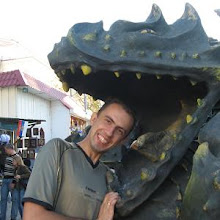When we bypassed Alchak mountain, we saw coast of Sudak and mountains behind it. They were our last points of route. Thus, after passing Sudak coast, we reached fortress mountain, where ancient fortress is located. It was founded in Middle Ages and belonged to different people in different times. But the most buildings of it were built by Italian colonists in XIV century. We walked in Sudak fortress more then an hour. But, if we had more time, we could spent more time there.
After that we left the city and went west by automobile road. We moved to one of the highest mountain in this region - Sokil. It isn't the highest one, but it has the most rapid slopes, which rises above the sea coast.
We spent the night on the mountain pass to the north of Sokil and ascended its summit next morning. Then we passed some mountains and returned to Sudak, where we sat down for transport home.
I made a lot of photos about Sudak, its fortress and towers, and, also, about our climbing Sokil summit. Here some of them:
After that we left the city and went west by automobile road. We moved to one of the highest mountain in this region - Sokil. It isn't the highest one, but it has the most rapid slopes, which rises above the sea coast.
We spent the night on the mountain pass to the north of Sokil and ascended its summit next morning. Then we passed some mountains and returned to Sudak, where we sat down for transport home.
I made a lot of photos about Sudak, its fortress and towers, and, also, about our climbing Sokil summit. Here some of them:
 View of Sudak coast
View of Sudak coast Mountain with Sudak fortress
Mountain with Sudak fortress Fortifications of Sudak fortress
Fortifications of Sudak fortress Ruins of ancient walls
Ruins of ancient walls View from mountain Sokil
View from mountain Sokil





























